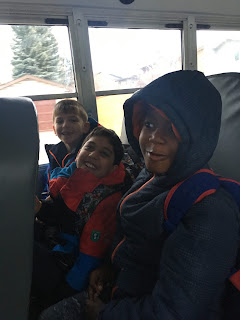Hello. Probably the biggest event of the week was Friday's championship flag-football game. The entire school came out to watch the Calgary Dinos take on the Mount Royal University Cougars. The Cougars prevailed in an action-packed, back-and-forth match. It was awesome!

In science this week we built our eco-columns. We had four environmental disasters where eco-columns were knocked over, but we quickly cleaned up and got them back in place. Because of the disasters, I'm afraid I forgot to get some video! I'll have some for next week. Anyway, our mealworms are now happily in their new homes along with red-wiggler worms, and we'll begin to collect data and document our project starting Monday. After building, our groups brainstormed what kinds of data they wanted to collect, what questions they wanted to ask and answer, and how they could go about it. We'll be measuring temperature using a digital infrared temperature gun. We will measure plant growth. We will study the life-cycle of our mealworms. We will examine the water cycle, among other things. We'll investigate the best ways to present our data, including graphing. We'll collect everything and make a final report.
In math we continue to work on arithmetic. As we master the algorithms, we'll continue to build our number sense and mathematical vocabulary. Word problems are a notoriously challenging area for many students. We'll begin this week with numberless word problems and build slowly from their, increasing our ability to think mathematically and to develop our ability to 'see' mathematics. Many students are able to perform pure calculations using algorithms (342 + 234, for example), but struggle to determine what exactly is being asked of them in a word problem. Numberless word problems are a great way to start introducing them to thinking about math in 'real world' applications. Take a look at this link to learn more: numberless word problems
In language arts, we worked on some creative writing, using a visual prompt from the great book, The Mysteries of Harris Burdick. We chose a creepy, Halloween themed picture, and the students had to use their imaginations to write a story based on it. It was a great success, and many of our students have taken their stories home to continue working on them. In this task, we were thinking about pacing, plot, grammar, spelling (how to use a dictionary), character, among other things.
We also continued our work on our Field Guide to the Birds of Peru. One of our goals is to practice writing, both for content but also legibility. Some of our students have come quite far in a short time. Below is one student who has progressed extremely well in his legibility and neatness. He was very proud of himself!
As you may know, every Friday the students participate in our Try Something New project. I am running a Lego Robot session where students build and then learn to program their robots. Today our first robots were completed, and programming began. Some Room 16 students are in this group, but most are in other groups. Ask your student what they are doing in their group!
This coming week, we'll be working with Room 17 to create a classroom wreath to present during our Remembrance Day assembly. We'll do some lessons on why we remember, what we're remembering, and examine some of the different roles Canadians have played in war.
The field trip forms for our TELUS Spark trip went home this week. Please ensure your child returns the signed copy to school as soon as possible. Relatedly, we are still looking for some volunteers to our upcoming field trip to Crowfoot Library. If you're interested, please contact me for more details.




















